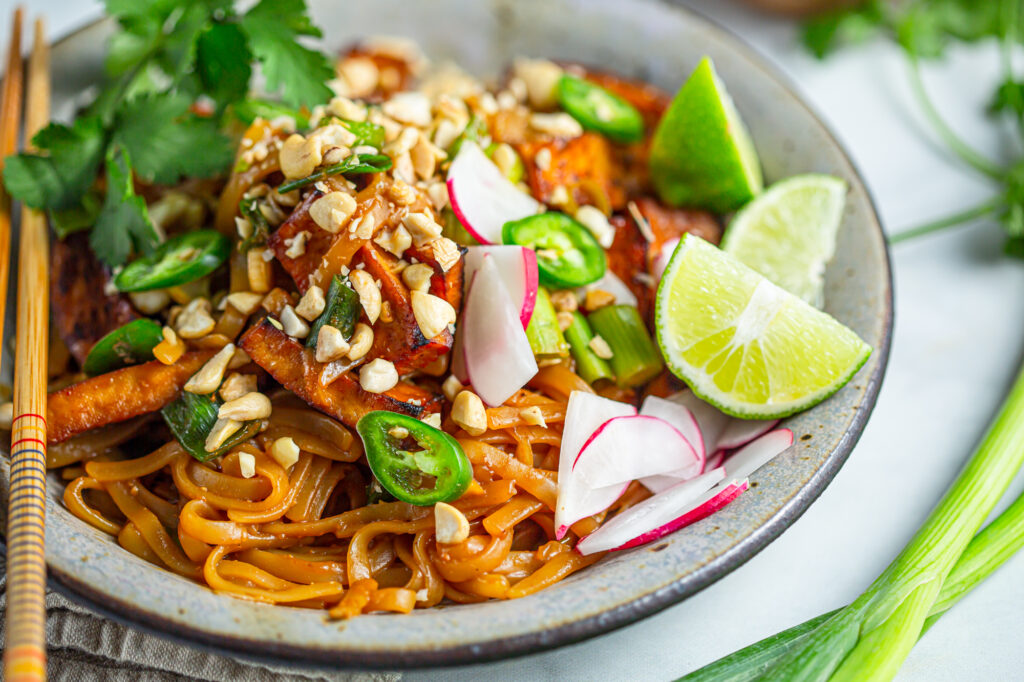Pad Thai is a beloved dish that has gained popularity worldwide. But the question remains: is Pad Thai healthy? This article delves into the nutritional aspects of Pad Thai, its health benefits, potential drawbacks, and how to make it a healthier option.
What is Pad Thai?
Pad Thai is a traditional Thai stir-fried noodle dish made primarily with rice noodles, eggs, peanuts, and a variety of proteins such as shrimp, chicken, or tofu. The dish is typically flavored with a sauce made from tamarind, fish sauce, sugar, and lime juice. Its origins trace back to the 1940s when the Thai government promoted it as a staple food to foster national identity and unity.
Nutritional Overview of Pad Thai
The healthiness of Pad Thai largely depends on its ingredients and preparation methods. Here’s a breakdown of the nutritional content based on various servings:
| Type | Calories | Protein (g) | Fat (g) | Carbohydrates (g) | Fiber (g) | Sodium (mg) |
|---|---|---|---|---|---|---|
| Meatless Pad Thai | 328 | 12 | 18 | 32 | 3 | 692 |
| Chicken Pad Thai | 306 | 18 | 14 | 29 | 3 | 684 |
| Seafood Pad Thai | 290 | 14 | 14 | 30 | 3 | 700 |
| Prepackaged Pad Thai (with chicken) | 429 | 20 | 2.5 | 82 | – | 659 |
As seen in the table, Pad Thai can be relatively high in calories and sodium, especially when prepared with sauces and oils that are rich in fats.
Health Benefits of Pad Thai
- Protein Source: Depending on the protein used (chicken, shrimp, or tofu), Pad Thai can provide a significant amount of protein. For instance, one serving can contain up to 20 grams of protein, which is essential for muscle repair and growth.
- Vitamins and Minerals: The dish often includes vegetables like bean sprouts and green onions, which contribute vitamins A and C, along with minerals like calcium and iron.
- Balanced Meal: When prepared with a variety of ingredients, Pad Thai can offer a balance of carbohydrates, proteins, and fats. The rice noodles provide energy-boosting carbs while the peanuts add healthy fats.
- Customizable: One of the greatest advantages of Pad Thai is that it can be easily modified to enhance its nutritional profile. For example:
- Increase Vegetables: Adding more vegetables can boost fiber content while reducing calorie density.
- Choose Lean Proteins: Opting for lean chicken or tofu instead of fatty meats can lower overall fat content.
- Control Sauces: Using less sauce or opting for low-sodium versions can help manage sodium intake.
Potential Drawbacks
While Pad Thai has its benefits, there are also some considerations to keep in mind:
- High Caloric Content: Depending on portion size and preparation methods, Pad Thai can be high in calories. A typical serving may range from 290 to over 400 calories, which could contribute to weight gain if consumed excessively.
- Sodium Levels: Many versions contain high levels of sodium due to fish sauce and soy sauce. This can be problematic for individuals monitoring their salt intake for blood pressure or heart health.
- Added Sugars: Some recipes include added sugars in the sauce, which can increase calorie counts without providing nutritional benefits.
- Fat Content: If cooked with excessive oil or fatty meats, the fat content can rise significantly. For example, some versions may contain up to 18 grams of fat per serving, which may not align with certain dietary goals.
Making Healthier Choices
To enjoy Pad Thai while maintaining a healthy diet, consider these tips:
- Portion Control: Be mindful of serving sizes; sharing a dish or saving half for later can help manage calorie intake.
- Vegetable Substitutions: Swap rice noodles for zucchini noodles or other vegetables for a lower-carb option.
- Homemade Sauces: Preparing your own sauce allows you to control sugar and sodium levels.
- Lean Proteins: Choose grilled chicken or tofu over fried options to reduce fat content.
- Skip the Extras: Avoid adding extra toppings like fried shallots or additional oil.
Real-Life Examples
Many restaurants offer variations of Pad Thai that cater to health-conscious diners:
- Health-Conscious Restaurants: Some establishments provide options like “light” Pad Thai made with less oil and sodium.
- Home Cooking: Individuals preparing Pad Thai at home have reported success by using fresh ingredients and adjusting sauces to taste.
Is Pad Thai Healthy for Weight Loss?
Pad Thai can be a part of a weight loss diet, but moderation and mindful choices are key. A typical serving contains around 290 to 429 calories, depending on the ingredients used. While it offers protein and essential nutrients, it can also be high in sodium and carbohydrates, which may impact blood sugar levels. To make Pad Thai more weight-loss friendly, consider using zucchini noodles instead of rice noodles, adding extra vegetables for fiber, and opting for lean proteins like chicken or tofu. By controlling portion sizes and ingredient choices, Pad Thai can fit into a balanced weight loss plan.
Is Chicken Pad Thai Healthy?
Chicken Pad Thai can be a tasty addition to a balanced diet, but its healthiness depends on preparation and portion size. A typical serving contains around 360 to 1,009 calories, with a macronutrient breakdown that includes 17-20 grams of protein and varying levels of carbohydrates and fats. While it provides essential nutrients like protein and vitamins from vegetables, it often has high sodium levels due to ingredients like fish sauce and soy sauce. To make Chicken Pad Thai healthier, consider using less sauce, adding more vegetables, and opting for lean chicken breast to reduce calories and sodium intake.
Conclusion
So, is Pad Thai healthy? The answer is nuanced. While it offers several nutritional benefits—especially when prepared thoughtfully—it also has potential drawbacks that should be considered. By making informed choices about ingredients and portion sizes, one can enjoy this delicious dish without compromising health goals.
In summary:
- Pad Thai can be healthy, particularly when customized with fresh vegetables and lean proteins.
- Be cautious about high calorie counts and sodium levels.
- Homemade versions allow for greater control over nutritional content.
With these insights in mind, you can savor every bite of this iconic dish while keeping your health in check!


